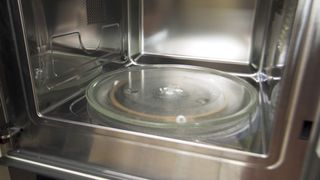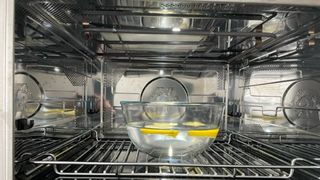How to clean a microwave with lemon: a natural method the experts love
They are a brilliantly helpful cleaning tool, so if you're wondering how to clean a microwave with lemon, here's a very easy step-by-step

Cleaning a microwave can be a dreaded cleaning task - not only are they usually in a spot that's awkward to reach, but they can also be one of the grimiest spots in the kitchen, full of grease, stuck on dirt, and slimy overspill. Because of this, knowing how to clean a microwave is an important skill – and knowing how to clean a microwave with lemon might just be even more helpful if you're looking for a natural method.
Though you may have your go-to method for cleaning this appliance, it’s worth considering whether using a lemon might be a superior option. Given that our microwaves are vessels we put food into on a regular basis, opting not to use chemicals for cleaning it can be preferable. Plus, it’s one of the most beneficial ways to use up any spare lemon halves!
Cleaning our microwaves is something we should be doing on a regular basis, especially if yours gets used daily. So if you’re wondering how to clean it using leftover lemon, here are what the experts suggest - and why it might be one of the most effective methods around for getting this appliance in tip-top shape once again.
How to clean a microwave with lemon
“Cleaning the microwave with lemons is actually one of the best ways to clean your microwave – and certainly the best way to leave it smelling great,” Matthew Harrison, cleaning expert at PriceYourJob explains.
Lemons are naturally antibacterial, which means that they are a popular choice for cleaning many different items around the home – for example, if you’re planning how to clean a burnt pan, or how to clean a shower properly.
However, the proper method should be followed when it comes to cleaning a microwave with a lemon; you can’t simply run the lemon across the interior of the microwave and scrub. The method for how to clean a microwave with lemon relies on the combination of lemon (of course) and steam, to help lift dirt from your microwave more easily – and sanitise it too. And it couldn’t be simpler.
What you’ll need:
Sign up for the woman&home newsletter
Sign up to our free daily email for the latest royal and entertainment news, interesting opinion, expert advice on styling and beauty trends, and no-nonsense guides to the health and wellness questions you want answered.
- A lemon
- A microwavable bowl
- Kitchen roll
- A microfibre cloth or sponge
- Water
1. Fill a bowl with water and lemon

To begin with, grab some water from your tap and fill up a bowl or a mixing bowl with water until it is about half full. Ensure the bowl is both microwave safe and heatproof, so it can withstand being heated up for a few minutes.
“Slice your lemon in half and squeeze some of the juice into the water. Then, place the lemon halves into the water," Matthew suggests. If you prefer though, you can also slice your lemon up into rounds, Area Supervisor at Cleanology, Jordan Ward, says.
"You can enhance the aroma by incorporating thinly sliced lemon. Typically one lemon will suffice, or opt for the convenience of two to three tablespoons of lemon juice if you need to," he said.
Then, give the entire thing a quick mix around with a wooden spoon, to allow the lemon juice to seep further into the water.
2. Heat the bowl in the microwave
Now, gently pick up your bowl full of water and lemon and place it on top of the microwave turntable.
After this, turn your microwave on for around 5 minutes, which should be enough time for the microwave to become full of lemony-steam. However, you may require more or less time depending on the size of your microwave, its power setting, and the size of the bowl you are using. Matthew suggests turning the appliance off "when the water starts to boil."
"Then, turn the microwave off – but don’t open the door," Matthew instructs. "The steam trapped inside will help to loosen up the grime and old bits of food. Allow it to stand for at least five minutes."
When the five minutes is up, the bowl should be cool enough for you to remove from the microwave. However, it’s wise to be careful during this step and use a tea towel or oven gloves to remove the bowl if needed.
3. Scrub your microwave

At this point, take the turntable out of the appliance, as this will make the entire cleaning process much easier. Matthew advises, "If the microwave has a turntable, remove this and give it a quick wipe clean. Set this aside and concentrate on wiping the inside of the microwave clean."
Your appliance should now be damp and steamy inside – meaning that now is the time to grab your microfibre cloth or sponge and start scrubbing. "Start with the ceiling and sides before cleaning the bottom, to catch any dirt that falls," Matthew says.
Be sure to tackle any corners where dirt might have built up, and dispose of any excess dirt or crumbs using a piece of kitchen roll. Similarly, wipe up any remaining water/moisture with another clean piece of kitchen roll.
4. Tackle difficult stains with this trick
If you come across any trickier stains whilst wiping your microwave down inside, Matthew suggests returning to your bowl of lemon water for the solution.
"If there are any stubborn spots of grime that don’t wipe away easily, dip your dish towel in the lemony water and scrub away until the spot is completely removed." It’s as easy as that!
5. Address the microwave turntable

Though you may have given the turntable a bit of a wipe down, it’s a great idea to give this part of your microwave a deeper clean if possible, given that this is where most food debris tends to fall.
You can use whatever method you prefer, but giving it a clean with some dishwashing liquid, hot water and a sponge is a fantastic idea, and will easily loosen and get rid of any stuck-on dirt or grease. Or, you can even pop yours in the dishwasher if you don’t need to use your microwave again urgently.
Once completed, leave the turntable to dry whilst you tackle the remaining part of the microwave.
6. Clean the microwave door
The doors of our microwaves are often missed when it comes to cleaning, but they can actually be one of the grubbiest parts, given that they are often touched with sticky hands.
You can again use your (likely now lukewarm) bowl of lemon water to tick off this job. As before, simply dip part of a clean kitchen towel into the water, ensuring that it isn’t drenched in water.
Then, wipe down the door, scrubbing a little harder at any grease around the ‘open’ button, or any stubborn stains. Finally, dry the door with a clean cloth, or piece of kitchen roll. And that's how to clean a microwave with lemon!
Is lemon good for cleaning the microwave?
Yes – lemons are a great option to use when cleaning a microwave, given that they are both safe and fantastic natural cleaners. "Lemons possess remarkable natural cleaning capabilities, providing effective cleansing without posing a threat to your appliances," Jordan explains.
"Their inherent antibacterial and anti-fungal properties make them an excellent choice for sanitising your microwave."
Not only that, but Matthew explains that it’s also one of the most effective methods around too, and should make cleaning very easy – which woman&home can testify to after trying the trick at home ourselves. "Cleaning the microwave with lemon is a very effective method," he says. "The lemon will loosen all of the dirt and grime, making it much easier to wipe away, and reducing the need for scrubbing."
What does putting a lemon in the microwave do?
If you’re keen to know a bit more of the ‘science’ behind cleaning a microwave with a lemon, Jordan explains that it’s all to do with the fact that the citric acid in the lemon will help to sanitise your appliance.
"Abundant in citric acid, lemon juice stands out as an exceptional natural cleanser, primarily thanks to its gentle acidity (low pH) and powerful antibacterial attributes."
And that's not all – a lemon will help to remove any nasty smells coming from your microwave too. Matthew says, "You may also have noticed that many cleaning products are lemon scented – that’s because lemon helps to remove and neutralise bad smells.”
Lemon is also a natural degreasing agent, which means that, once steamed alongside your water, it will help to cut through any grease in your microwave very effectively.

Is it better to clean the microwave with lemon or vinegar?
If you prefer using natural ingredients to get your microwave spick and span, you can also use vinegar to clean this appliance. Cleaning with vinegar is a fantastic option, as it is also acidic in nature, which means that it can easily help to dissolve and dislodge stubborn dirt.
And actually, the method for cleaning your microwave with vinegar is very similar to cleaning it with lemon, Matthew says. "Simply follow the same method as above, but replace the lemons with two teaspoons of white vinegar."
Cleaning expert Heidi Phillips, owner of cleaning company The Organised Home and Mind, breaks down the ideal method for cleaning your microwave with vinegar. "Fill a bowl with a pint of water and 2 teaspoons of white vinegar. Place it in the microwave and turn it on for 5-10 minutes. Remove the bowl using oven gloves to prevent scalding, and then easily wipe away the softened dirt."
So which method is superior? Both methods should be just as effective as the other, but many people prefer to use lemons, as this option provides a much more pleasant smell both during the process, and after – after all, a lemony fresh scent is often far more preferable to a more acidic vinegar smell.
Amy Hunt is an experienced digital journalist specialising in homes, interiors and hobbies. She began her career working as the features assistant at woman&home magazine, before moving over to the digital side of the brand where she eventually became the Lifestyle Editor up until January 2022. Amy won the Digital Journalist of the Year award at the AOP Awards in 2019 for her work on womanandhome.com.
